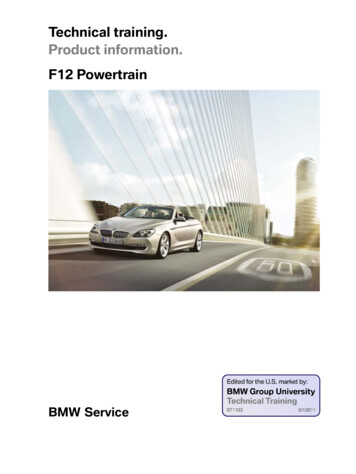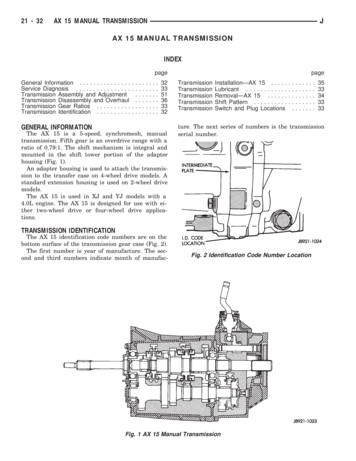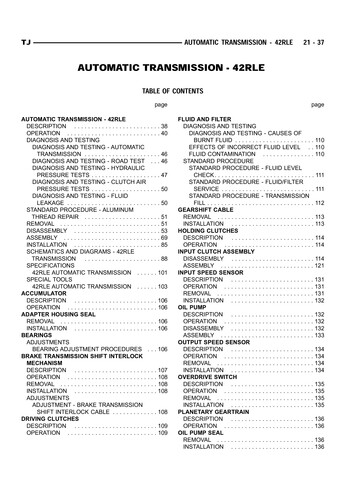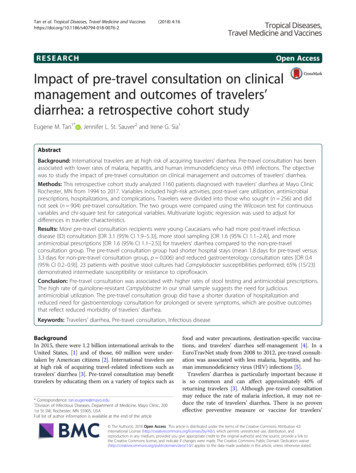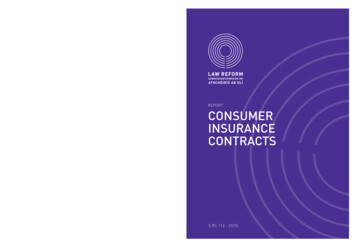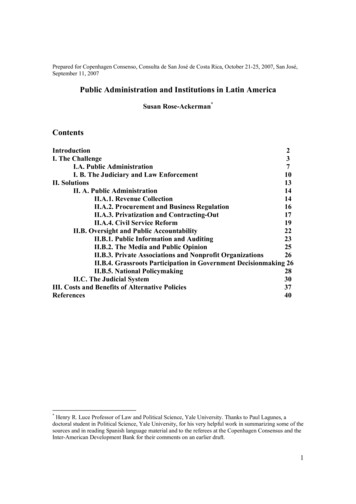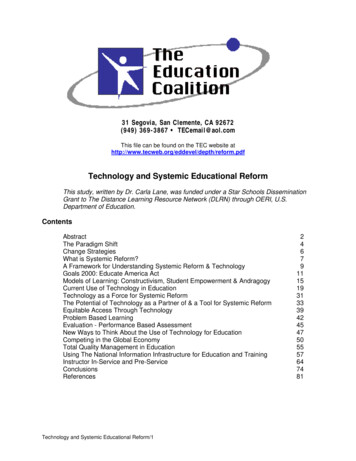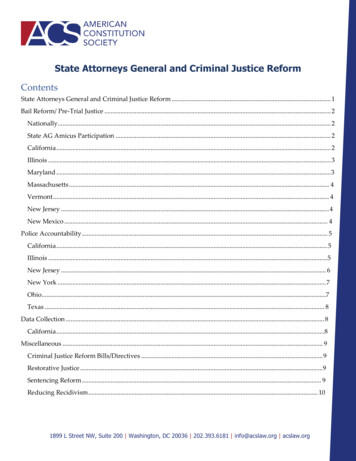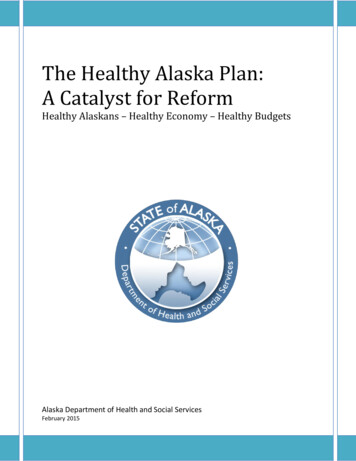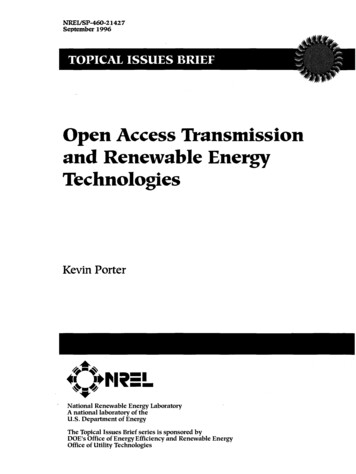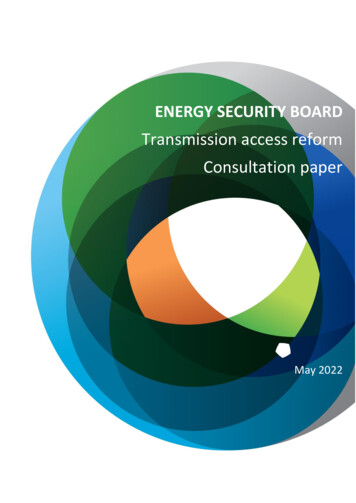
Transcription
ENERGY SECURITY BOARDTransmission access reformConsultation paperMay 2022April 20221
Anna CollyerChairAustralian Energy MarketEnergy Security BoardCommissionandClare SavageChairAustralian Energy RegulatorDaniel WestermanChief Executive OfficerAustralian Energy Market Operator2
Table of ContentsExecutive Summary . 51234Introduction . 81.1Context . 81.2Process . 81.3Objectives and assessment criteria . 10Case for change . 142.1Congestion will be more common in the future . 142.2Current arrangements for managing congestion . 152.3Consequences of current arrangements for managing congestion . 172.4Role of access reform in supporting REZs . 23Shortlisted models . 253.1Overview of model options. 253.2Congestion zones with connection fees. 263.3Transmission queue . 323.4Congestion management model (CMM) with universal rebates. 393.5Congestion relief market (CRM) . 45Next steps . 50Appendix ASummary of consultation questions. 51Appendix BCurrent market design . 52Appendix CInvestment timeframes . 56C.1CMM – REZ adaptation . 56C.2Physical access rights via locational connection fees . 60C.3REZ cost allocation model . 64C.4Shaped marginal loss factors . 67Appendix DOperational timeframes . 71D.1Revised tie-breaker rules . 71D.2Dual price floors . 743
List of AbbreviationsAEMCAustralian Energy Market CommissionAEMOAustralian Energy Market OperatorAERAustralian Energy RegulatorCOGATI Coordination of Generation and Transmission InvestmentCMMCongestion management modelCRMCongestion relief modelEOIExpressions of interestESBEnergy Security BoardESSEssential System ServicesESOOElectricity Statement of OpportunitiesFCASFrequency Control Ancillary ServicesGWGigawattISPIntegrated System PlanLHSLeft hand sideMWMegawattMWhMegawatt hourNEMNational Electricity MarketNEMDENational Electricity Market Dispatch EngineNEONational Electricity ObjectivePPAPower purchase agreementREZRenewable Energy ZoneRHSRight hand sideRIT-TRegulatory Investment Test for TransmissionRRNRegional Reference NodeRRPRegional Reference PriceTNSPTransmission Network Service ProviderTWhTerawatt hourVREVariable renewable energy4
Executive SummaryAs the National Electricity Market (NEM) transitions towards higher levels of variable renewableenergy (VRE) and flexible resources such as storage and hydrogen, transmission congestion willincrease. This is expected despite the significant investment in transmission augmentation. The energytransition can be delivered more cheaply and quickly if new generators and storage connect in placesthat facilitate the full benefit of all these resources coming into the national power system.In some cases, generators are connecting in locations where, a lot of the time, they are not addingnew renewable energy to the power system. Instead, they are displacing the existing renewablegenerators. If we don’t change the access regime, we are likely to end up with a larger generation andstorage fleet and transmission network than necessary to achieve the same decarbonisation andreliability outcomes (see Figure 1).These issues are being recognised by some State governments who have sought to progress reformsto implement renewable energy zones (REZ) within their regions. The work of the Energy SecurityBoard (ESB) aims to support and dovetail with these initiatives.Figure 1 Consequences of failing to act on access reformUnnecessary investment ingenerators and storage thatare poorly located to bedispatched.Subsequent connections canrender neighbouringprojects unviable.Investment is moreexpensive than it should bebecause the additional riskand uncertainty adds to thecost of capital faced bygeneration investors.Investments aremore expensive dueto systemic risksInvestments arepoorly targetedIf generators and storagelocate in the wrong place, alarger transmission system isneeded to transport energyfrom sources of supply toload.Additionaltransmissionexpenditure Storage can help to reducecongestion costs, but it is notpaid to do so.Storage providers lose apotential value stream, andthe NEM loses an importanttool to manage congestion.Lost opportunity tobenefit from storageIn operational timeframes,more expensivecombinations of generationand storage are being used tomeet demand than isnecessary.More expensivedispatch outcomesNational Cabinet has instructed the ESB to progress detailed design work on transmission accessreform for the NEM and to submit a proposed rule change to Energy Ministers by December 2022.The design process should include a comprehensive consultation process and take into considerationvalue for money, locational signals and ensuring sufficient flexibility for jurisdictional differences.11Refer to Summary of the final reform package and corresponding Energy Security Board, published October 20215
In November 2021, the ESB published a project initiation paper that gave stakeholders the opportunityto submit alternatives to its preferred model at the time, being the congestion management model(CMM) adapted for REZs.2In January 2022, the ESB received 18 submissions, with stakeholders proposing a range of alternatemodels in various stages of development. Ten model options have been assessed. The ESB hasengaged with stakeholders to understand their proposals and identify the best features of theproposed model designs. The models were then assessed against a set of access objectives andassessment criteria that were developed in collaboration with the ESB’s Congestion ManagementTechnical Working Group.The ESB’s transmission access objectives relate to two different timeframes – the time wheninvestment decisions are made, and the operation of the power system in real time. We have refinedthe transmission access objectives to clarify how the objectives map to these timeframes.Figure 2 Summary of transmission access objectivesInvestment timeframesThe level of congestion in the system is consistentwith the efficient level.1. Investment efficiency: Better long-term signals formarket participants to locate in areas where they canprovide the most benefit to consumers, consideringthe impact on overall congestion.2. Manage access risk: Establish a level playing fieldthat balances investor risk with the continuedpromotion of new entry that contributes to effectivecompetition in the long-term interests of consumers.Operational timeframesWhen congestion occurs, we dispatch the leastcost combination of resources that securely meetsdemand.3. Operational efficiency: Remove incentives fornon-cost reflective bidding to promote betteruse of the network in operational timeframes,resulting in more efficient dispatch outcomesand lower costs for consumers.4. Incentivise congestion relief: Create incentives for demand side and two-way technologies to locatewhere they are needed most and operate in ways that benefit the broader system.This categorisation by timeframe also applies to the access models suggested to us by stakeholders,which typically focus on either investment or operational timeframes. It is necessary to develop asolution for each timeframe to meet the transmission access objectives.Based on stakeholder feedback and our assessment against the access objectives, the ESB hasshortlisted four out of the ten models. The operational and investment timeframe models can bemixed and matched. Our comprehensive consultation process has prompted us to remove the REZadaptation of the CMM from our shortlist. Instead, we will focus on developing a congestionzone/connection fee-based model. We consider this model will avoid the concerns raised by investorstakeholders with the REZ adaptation of the CMM.2ESB, Transmission access reform – Project initiation paper, November 2021. Available at: nal.pdf6
Table 1 Shortlisted models for detailed designInvestment timeframesOperational timeframesCongestion zones with connection feesCMM with universal rebatesInvestors receive clear up-front signals about whichnetwork locations have available hosting capacity.Establishes a single, combined-bid energy andcongestion marketTransmission queueCongestion relief market (CRM)Establish a transmission queue that confers priorityrights (either to allocate rebates in the CMM or toestablish who buys and sells congestion relief in theCRM).Changes to the market and settlements to provideseparate revenue streams for energy and congestionrelief.A whole-of-system transmission access solution is a key complementary reform that will support andstrengthen State REZ schemes by: strengthening incentives for new entrants to locate and participate in REZ investmentsgiving REZ participants confidence that their investment case will not be undermined bysubsequent inefficient investment that locate outside the REZ in the broader shared networkremoving opportunities for subsequent connecting generators to “free-ride” on REZ transmissioninvestments without contributing to thempromoting the efficient use of REZ transmission infrastructure by creating a market design thatrewards storage providers for alleviating transmission congestion and providing firming servicesfor renewable generators.It will be important to balance the duration of access rights, which provide revenue certainty forcurrent investments, against the need to incentivise cheaper new entrant technology in the future topromote effective competition in the wholesale market over the long-term.In the medium to long term, the NEM’s version of open access is incompatible with REZs because it isan unstable foundation for co-ordinated system development. The ESB has been working closely withjurisdictions as it develops this paper, including through its jurisdictional advisory group. We outlinein this paper how the various model options could dovetail with REZs.The purpose of this consultation paper is to seek feedback on the four model options, which will guidethe next stage of detailed design. Going forward, the ESB will continue to work with stakeholders todevelop these models to a sufficient level of detail to support a recommendation to Ministers. TheESB anticipates that detailed design will be a hybrid model that incorporates one of the investmentmodels and one of the operational models set out in this paper. As part of this work, we will considerthe implementation costs associated with the different models. While all models require furtherdesign and development, in their current forms, there is a very substantial differential inimplementation costs between the operational timeframe models. Being more expensive does notpreclude a model from being selected, but the additional costs would need to be offset bycommensurately higher benefits relative to the alternative options.The paper also shares the assessment outcomes of the remaining six models. While they will notprogress on a standalone basis, elements of their design features have been incorporated into theshortlisted versions.Submissions on this paper are due by 10 June 2022.The ESB will hold a public webinar on 26 May 2022 to assist stakeholders with their submissions.7
1 Introduction1.1 ContextNational Cabinet has instructed the ESB to progress detailed design work on transmission accessreform and to propose a rule change to Energy Ministers by December 2022. To deliver on this task,the ESB will seek to: address the problems that prompted National Cabinet to ask the ESB to conduct the review,namely, the problems associated with the current access regimework with stakeholders to understand their concerns and respond to them whereappropriate, including by considering alternative mechanisms proposed by stakeholdersensure sufficient flexibility for jurisdictional differences.While the ESB recognises there are critical interdependencies between transmission access andtransmission investment, they are distinct, and this review is focused on the former. Transmissioninvestment is being considered as part of the AEMC’s Transmission Planning and Investment Review.3The purpose of this consultation paper is to seek feedback on four model options, developed throughsignificant stakeholder consultation, which will guide the design choices during the next stage ofdetailed design. Going forward, the ESB will continue working with stakeholders to assess and developa preferred model to recommend to Ministers. The ESB anticipates that detailed design will be a hybridmodel that incorporates one of the investment models and one of the operational models set out inthis paper.1.2 ProcessThe ESB initiated this project by publishing an initiation paper on 26 November 2021. The paper setout the project’s objectives, assessment criteria and timeframes. The ESB’s priority was to identifynew, alternate access reform models. The ESB received 18 submissions with seven alternate modelsproposed by stakeholders. Several stakeholders developed models in response to the project initiationdocument. In addition, we were asked to consider several models that were developed in the contextof other reviews. In total, ten models have been assessed. Of the ten proposals: Four models are shortlisted for further consideration; of which two address objectives ininvestment timeframes and two in operational timeframes.Six models are deprioritised. These models did not satisfy the transmission access reformobjectives on a standalone basis. However, some of the design elements of these modelsmerit further consideration and have been incorporated into the shortlisted versions.The shortlisting is an outcome of extensive stakeholder engagement, including public forums, workinggroups and industry briefings. In February 2022, the ESB held a virtual seminar to give interestedparties the opportunity to understand and discuss the various models proposed by stakeholders asalternatives to the congestion management model. Members of the ESB’s Congestion ManagementTechnical Working Group and Jurisdictional Advisory Group have also made significant contributionsto our work. Further information on the ESB’s stakeholder engagement process is available here.The ESB is seeking stakeholder feedback regarding the options that will best address the access reformobjectives. The process for making a submission is described in Chapter 4.3 See smission-planning-and-investment-review8
Over the coming months, we will continue to work with stakeholders to further develop the shortlistedmodels to gain a better understanding of how they would work in practice, and their strengths andweaknesses. Going forward, this work will enable us to develop and consult on a draft hybrid modelthat addresses the objectives in both investment and operational timeframes.Figure 3 Stages of the design process and next stepsSource: ESBAt the end of the next stage, the ESB will select the best performing options for each timeframe inorder to develop a single model for the draft recommendation. The ESB considers that each of thesemodels have the potential to improve from the status quo and be in the long-term interest ofconsumers.The ESB would like to acknowledge the collaborative response from stakeholders in developing andassessing the model options. Transmission access reform challenges have persisted since thebeginning of the NEM and the constructive approach of stakeholders has provided a strong foundationfor the ESB to proceed to the next detailed design phase. In particular, we would like to thank workinggroup members and model proponents for their engagement on the challenge of access reform. Wewish to continue this collaborative approach to develop the best access reform model to meet thecurrent and future challenges of a transitioning power system.9
1.3 Objectives and assessment criteriaThe congestion management detailed design process seeks to identify the model/s that best promotesall four of the transmission access reform objectives.The project initiation paper4 set out draft objectives and assessment criteria, which provide criticalparameters for this workstream. They form the basis of our analysis of alternate congestionmanagement models including our explanation as to which models will (and will not) be progressedbeyond this consultation paper. The objectives and assessment criteria have been refined based onfeedback from the Congestion Management Technical Working Group.1.3.1 Access reform objectivesThe refined objectives and assessment criteria are set out below. They outline the desired outcomesof the reform. A summary of the stakeholder feedback on the draft version, together with changessince the project initiation paper, can be found here in the Technical Working Group’s meetingmaterials that are published on the ESB website.The ESB has refined its language to articulate its intent more clearly with respect to Objective 2. Theprevious phrasing of “increased investor confidence” could be interpreted as needing to restrict futureconnections (and associated competition or network utilisation benefits) to maintain the access ofexisting connections. The ESB does not consider this to be the intended objective of transmissionaccess reform, nor is the reform intended to be exclusively investor focused. Access reform seeks toaddress the current market design limitation whereby congestion costs are caused by a producer butare not borne by the producer. We are not seeking to protect incumbents from competition, butrather to address limitations with the current market design and enable investors to actively managerisk that arises beyond a naturally competitive market.We also recognise that the scale of the transition means that significant amounts of new resourcesneed to connect to the system. AEMO’s draft Integrated System Plan (ISP) suggests we need 122gigawatt (GW) of additional variable renewable resources by 2050 in the Step Change scenario.Therefore, we are mindful to avoid making this transition harder than necessary to achieve.While the first three objectives capture all technologies, the fourth objective explicitly notes theimportance of providing signals for technologies that can alleviate congestion, both in operational andinvestment timeframes. This includes, for example, grid-scale battery storage and demand-sideresources, including hydrogen. The role of such technologies is important in facilitating the currentenergy sector transition in a way that ensures efficient network utilisation and, in turn, that consumerspay no more than necessary.Other refinements include amending language to ensure the objectives are technologically neutraland acknowledging that new generation can contribute other benefits to the system beyondcompetition benefits, such as system security and reliability.4ESB, Transmission access reform – Project initiation paper, November 2021. Available at: nal.pdf10
Figure 4 Access reform objectivesInvestment timeframesGoal: Level of congestion in the system is consistentwith the efficient level.1.Operational timeframesGoal: When congestion occurs, we dispatch theleast cost combination of resources that securelymeets demand.Investment efficiency (locational signals):Better long-term signals for generators, storageand scheduled loads to locate in areas withavailable and proposed transmission capacity –including, but not necessarily limited to, REZsdelivered in line with the ISP and state governmentpolicies – where they can provide the most benefitto consumers, taking into account the impact onoverall congestion.3. Operational efficiency (dispatch signals):Remove incentives for non-cost reflectivebidding to promote better use of the network inoperational timeframes, resulting in moreefficient dispatch outcomes and lower costs forconsumers.2. Manage access risk:Address elements of the current market design thathave the effect of amplifying investor risk abovewhat would occur in a natural competitive market.The intent is to achieve a level playing field thatbalances investor risk with the continuedpromotion of new generation and storage entrythat contributes to effective competition, reliabilityand system security in the long-term interests ofconsumers.4. Providing the right signals for alleviating congestion:Establish a framework that incentivises technologies that can help to alleviate congestion (e.g. storage anddemand-side resources) to locate where they are needed most and operate in ways that benefit the broadersystem.Source: ESB1.3.2 Assessment criteriaThe ESB has also refined the set of criteria on how it will assess the proposed models to move towardsa draft recommendation. The criteria draw upon National Cabinet’s decision, the four core objectives11
for transmission access reform, and the ESB’s statutory duty to make recommendations that areconsistent with the national electricity objective (NEO).5The refined assessment criteria are set out in Table 2. We recognise that the assessment criteriacannot all be perfectly met but must be traded off to achieve a balance that best promotes the longterm interests of consumers. A model that strongly meets an individual criterion may score lower onothers. The criteria will not be treated as a box ticking exercise but rather as a balancing act to selectthe most suitable model and the best detailed design features within the model, for example,comparing the costs of implementation with the expected benefits to be achieved.Table 2 Access reform assessment criteriaCriteriaDescription1Efficient marketoutcomes –investment 2Efficient marketoutcomes dispatch 3Appropriateallocation of risk 4Manage accessrisk 5Effectivewholesalecompetition 6Implementationconsiderations 75Integration withjurisdictional REZschemes Better incentives for generators, storage such as batteries, and load suchas hydrogen electrolysers to locate in efficient areas. In the case ofgeneration, this is most likely where there are low congestion levels, suchthat transmission assets are better utilised. In the case of storage and load,these may be congested areas to help alleviate that congestion and useotherwise wasted renewable electricity that could not reach the load.Better incentives for generation, storage such as batteries, and load suchas hydrogen electrolysers to bid in a fashion that best reflects its underlyingcosts, resulting in more efficient dispatch outcomes and reducing fuel costsacross the NEM. In turn, this may also reduce emissions.Risk arising due to congestion in the NEM should be allocated, to the extentpossible, to the party that is best placed to manage or otherwise bear thatrisk, noting the practical limitations on exposing parties to risk withoutappropriate mitigation tools and measures.Lower risk to investors, where the benefits of doing this outweigh the costs(from a consumer perspective), by addressing the features of the currentmarket design that amplify access risk.Facilitate market participants’ ability to manage access risk.Managing the risk arising from regulatory change, i.e. consider whetherthere are strategies to mitigate the impact of the changes on marketparticipants.Any changes should promote an effectively competitive wholesale marketby avoiding creating barriers to new entry; any additional costs to newentrants associated with their transmission connection reflects a benefit(s)they receive in return.Cost and complexity: cost and complexity of implementation, including theimpact of the system’s physical complexities and ongoing regulatory andadministrative costs to all market participants, consumers and marketbodies, compared to the expected benefits of the option, and as comparedto the status quo.Timing and uncertainty: uncertainty of outcome, the likely timing ofbenefits versus costs.As requested by Ministers, the proposed rules must provide flexibility suchthat differences between jurisdictions’ access schemes, including thosewithout REZ schemes, can be appropriately integrated.Section 90F(4)(b) mandates that for South Australian Minister made Rules on recommendation from the ESB the ESBmust is satisfied that the Rules are consistent with the national electricity objective (NEO).12
Criteria 3, 4 and 5 reflect the balancing interests of different parties (consumers, investors/incumbentsand new technology providers). We deemed it necessary to separate these criteria to ensure that eachis fully considered. Some models re-allocate risks but may not facilitate management of those riskse.g. models that transfer risk from market participants to customers. Alternatively, a model mayenable investors to manage their risk, but in a way that creates barriers to new entry. This is a keytrade-off when designing the models – that is, the appropriate balance between investors’ ability tomanage risk and promoting effective wholesale competition over the long-term – with the overall goalbeing the long-term interest of consumers, consistent with the NEO.13
2 Case for changeTo understand the nature of the congestion challenge we need to understand: that congestion is an inherent feature of a high VRE power system, and hence, we need to beable to manage it wellhow we currently manage congestionhow these arrangements lead market participants to make decisions that are individuallyprofitable but lead to inefficient outcomes for the broader systemwhy access reform is required to support jurisdictional REZ schemes.This chapter outlines these issues and discusses the consequences for customers if we fail to reform.2.1 Congestion will be more common in the futureCongestion is a normal, everyday feature of efficiently sized transmission infrastructure toaccommodate VRE. It is not an anomaly. It can be profitable for solar developers to build solar farmsthat produce surplus output during the middle of the day, so that they can produce more during thelucrative shoulder periods. It would be inefficient for the transmission network to be able toaccommodate all this surplus generation.AEMO’s 2022 draft ISP forecasts that congestion will continue to increase even after the actionableISP projects are built. The ISP does not, and should not, seek to remove all congestion from the system.Doing so would impose substantial costs on consumers. Issues relating to access will be commondespite the transmission infrastructure expansions foreshadowed by the ISP. The draft ISP projects aneed for 63 GW of transmission network capacity to accommodate approximately 127 GW of utilityscale VRE by 2050 i.e. transmission capacity is less than half of utility-scale VRE capacity.Figure 5 Projected utility-scale VRE in REZ for the NEM, the transmission network capacity to facilitate thisdevelopment together with the economic spill and transmission curtailment66AEMO, Appendix 3 Renewable Energy Zones Draft 2022 ISP for the National Electricity Market, December 2021, p.11.14
It should be noted that the lost output due to transmission curtailment and spill in the chart above iscumulative i.e
ESB, Transmission access reform - Project initiation paper, November 2021. Available at: https://www.datocms- . rewards storage providers for alleviating transmission congestion and providing firming services for renewable generators. It will be important to balance the duration of access rights, which provide revenue certainty for .
